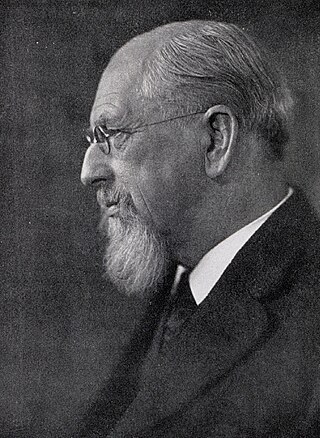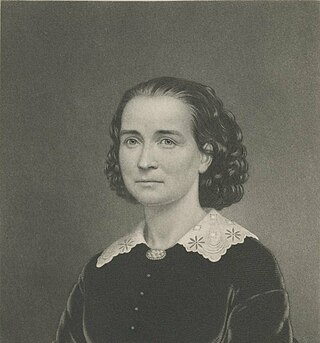
Georgetown Female Seminary (later, Waverley Seminary) was an American school for young women located in Georgetown, Washington, D.C.

Georgetown Female Seminary (later, Waverley Seminary) was an American school for young women located in Georgetown, Washington, D.C.
Lydia S. English founded the school in 1826 when she was only sixteen years old. [1] English's father had recently remarried and she founded the school as a way to live apart from her new stepmother. [1] English received no support from her family for her new endeavor. [1] The first class included just three students: Jane Wann, Eliza Henderson, and Miss Perry. [1]
The school quickly expanded to serve the daughters of Washington politicians. [1] In 1835, the school had 130 pupils.[ citation needed ] Under English, the curriculum included botany. [2] Noted writer Caroline Healey Dall taught at the school in the Fall and Winter of 1842. [3]
According to the papers of Andrew Johnson, it cost $33.81 for Martha Johnson Patterson to attend Miss English's Female Seminary between December 2, 1844 and February 12, 1845. [4] Lodging and laundry service brought the total to $39.99. [5]
The seminary was three floors high and contained 19 bedrooms, a library, several parlors, and porches on the wings. [6] It even had running hot water. [6] The Union Army confiscated the seminary in 1861 during the Civil War and turned it into a hospital for officers. [6] It is believed that Mary Edwards Walker, the first woman to win the Medal of Honor, served here. [6]
English was a secessionist. [6] Enslaved people helped run the school under English. [3] While the school was being used as a hospital, English moved out of sight around the corner to 2812 N Street. [6]
Lydia S. English died on February 24, 1866. She is buried at Oak Hill Cemetery in Washington, D.C. [7]
On September 12, 1868, Mary E. Bibb and Miss S. A. Lipscomb organized the Georgetown Female Seminary. [8] Bib and Lipscomb were sisters from a family of teachers. [8] Their brother, Andrew Adgate Lipscomb, was chancellor of the University of Georgia for fifteen years. [8] Both women were graduates of Lydia S. English's school. [8]
The school increased in thrived under the new management and continued to educate the daughters of prominent families. [8] After three years, Bibb retired. [8] Lipscomb ran the school after 1871. [8]
In The Yearbook of Education for 1879 the Georgetown Female Seminary is described as "A Select Boarding and Day School for Young Ladies and Children." [9] The school began with a kindergarten department and ended with a collegiate department. [9] Courses offered included modern languages, music, drawing and bookkeeping. [9] The principals were Mrs, Zelia D. Butcher and Miss Mary C. Douglas. [9] The school was located at 1023 12th St NW, Washington DC. [9]
After 10 years, Lipscomb renamed the school as Waverley Seminary and relocated to a more central area of Washington DC. [8] Dolly Blount Lamar attended around 1878 and she described it as a "combination preparatory and finishing school for young ladies from the South." [10]
According to The Yearbook of Education for 1879, French conversation was a specialty of the school. [9] At this point, Waverly Seminary was located at 1412 H St NW, Washington DC. [9]
Hopewell may refer to:

William Healey Dall was an American naturalist, a prominent malacologist, and one of the earliest scientific explorers of interior Alaska. He described many mollusks of the Pacific Northwest of America, and was for many years America's preeminent authority on living and fossil mollusks.
Georgetown Day School (GDS) is an independent coeducational PK-12 school located in Washington, D.C. The school educates 1,075 elementary, middle, and high school students in northwestern Washington, D.C. Russell Shaw is the current Head of School.

Yolande Margaret Betbeze Fox was an American singer and beauty pageant titleholder who was crowned Miss America 1951.

Andrew Adgate Lipscomb was an American clergyman and educator.

Thomas John Rodi is an American prelate of the Roman Catholic Church. He has been serving as archbishop of the Archdiocese of Mobile in Alabama since 2008, having previously served as bishop of the Diocese of Biloxi in Mississippi from 2001 to 2008.

Newton D. Baker House, also known as Jacqueline Kennedy House, is a historic house at 3017 N Street NW in Washington, D.C. Built in 1794, it was home of Newton D. Baker, who was Secretary of War, during 1916–1920, while "he presided over America's mass mobilization of men and material in World War I. After the assassination of president John F. Kennedy in 1963, Jacqueline Kennedy purchased the house and lived here for about a year.

Walter Smith Cox was an associate justice of the Supreme Court of the District of Columbia.

Clement Moore Butler (1810–1890) was an Episcopal priest, author, and seminary professor who served as Chaplain of the Senate from 1850 to 1853.
Andrew Fowler was a Baptist minister, educator, school administrator, counselor, political and religious adviser, church statesman and civil rights activist in Washington D.C.
Caroline Wells Dall was an American feminist writer, transcendentalist, and reformer. She was affiliated with the National Women's Rights Convention, the New England Women's Club, and the American Social Science Association. Her associates included Elizabeth Peabody and Margaret Fuller, as well as members of the Transcendentalist movement in Boston.

The Lucy Cobb Institute was a girls' school on Milledge Avenue in Athens, Georgia, United States. It was founded by Thomas R.R. Cobb, and named in honor of his daughter, who had died of scarlet fever at age 14, shortly before construction was completed and doors opened; it was incorporated in 1859. The cornerstone for the Seney-Stovall Chapel was laid in May 1882, and the octagonal building was dedicated in 1885. The school closed in 1931.
Live Oak Female Seminary was a Presbyterian female seminary and boarding school in Gay Hill, Washington County, Texas from 1853 to 1888. Many daughters of the Southern aristocracy were educated here.
Mary Elizabeth Bibb was an American-born educator and abolitionist leader. She is considered by some to be the first female black journalist in Canada. She was a teacher and abolitionist in the United States, before moving with her husband Henry Bibb to Canada after the passage of the Fugitive Slave Act of 1850 which made it very easy for slavecatchers to capture fugitive and free Blacks. She established schools for Black Canadians, published the Voice of the Fugitive newspaper, and helped African Americans get settled in Canada.

William Matthews, occasionally spelled Mathews, was an American who became the fifth Roman Catholic priest ordained in the United States and the first such person born in British America. Born in the colonial Province of Maryland, he was briefly a novice in the Society of Jesus. After being ordained, he became influential in establishing Catholic parochial and educational institutions in Washington, D.C. He was the second pastor of St. Patrick's Church, serving for most of his life. He served as the sixth president of Georgetown College, later known as Georgetown University. Matthews acted as president of the Washington Catholic Seminary, which became Gonzaga College High School, and oversaw the continuity of the school during suppression by the church and financial insecurity.

Caroline van Hook Bean was an American painter.

Martha Johnson Patterson was the eldest child of Andrew Johnson, the 17th President of the United States and his wife, Eliza McCardle. She served as the White House hostess during her father's administration and directed the restoration of the White House following the American Civil War. A newspaper article published at the time of her death stated, "'Too much cannot be said in praise of her many virtues.'...president Johnson once told a United States Senator—still living in Washington—that Mrs. Patterson 'was the only child he had who had been a comfort to him, or taken pride in his career.'"
Leila Mechlin was an American art critic. Writing from 1900 to 1946, she was the first female art critic in the United States. She was a cofounder of the American Federation of Arts and founding editor of its arts journal. She was an elected member of the Royal Society of Arts in London.

Mary Fenn (Robinson) Davis (1824-1886) was a reformer, spiritualist lecturer, and poet. She was a member of Sorosis, a women's club. She was married several times, first to Samuel G. Love, with whom she had a son. Her marriage to Andrew Jackson Davis after her divorce caused a scandal. She fought against alcohol consumption and slavery and for women's rights.
lydia english.
Miss Lydia S. English georgetown.